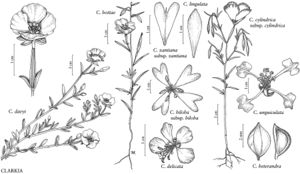Clarkia delicata
Bot. Gaz. 65: 60. 1905.
Stems erect, 20–70 cm, glabrous and glaucous distally, usually puberulent basally. Leaves: petiole to 10 mm; blade lanceolate to elliptic or ovate, 1.5–4 cm. Inflorescences open racemes, sometimes branched, axis straight; buds pendent. Flowers: floral-tube 2 mm; sepals reflexed together to 1 side; corolla rotate, petals oblanceolate to obovate, 8–12 mm, claw tapered, shorter than blade, apex entire; stamens 8, unequal, outer anthers orange-red, inner smaller, paler. Capsules 15–35 mm; subsessile. Seeds brown, 1–1.5 mm, tuberculate (especially on raphe), crest inconspicuous. 2n = 36.
Phenology: Flowering Apr–May.
Habitat: Oak woodlands, chaparral.
Elevation: 0–1000 m.
Distribution
Calif., Mexico (Baja California)
Discussion
Clarkia delicata is known in California only from the Peninsular Ranges, mainly in San Diego County with outliers in Riverside and San Bernardino counties, and in northern Baja California, Mexico. Because of its limited range, it is listed as rare by the California Native Plant Society. It is a tetraploid derived from hybridization between C. epilobioides and C. unguiculata.
Selected References
None.
